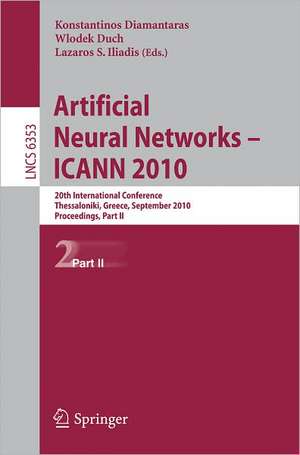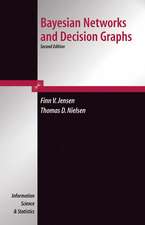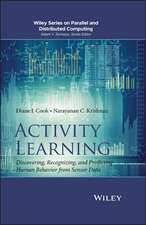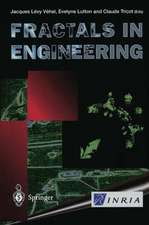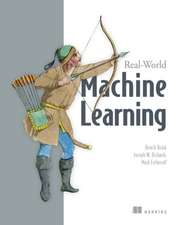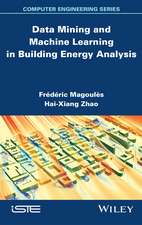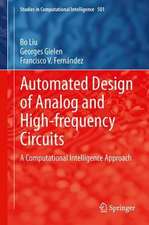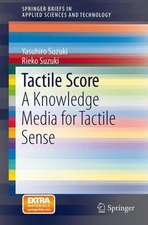Artificial Neural Networks - ICANN 2010: 20th International Conference, Thessaloniki, Greece, Septmeber 15-18, 2020, Proceedings, Part II: Lecture Notes in Computer Science, cartea 6353
Editat de Konstantinos Diamantaras, Wlodek Duch, Lazaros S. Iliadisen Limba Engleză Paperback – 3 sep 2010
| Toate formatele și edițiile | Preț | Express |
|---|---|---|
| Paperback (3) | 347.74 lei 6-8 săpt. | |
| Springer Berlin, Heidelberg – 3 sep 2010 | 349.40 lei 3-5 săpt. | |
| Springer Berlin, Heidelberg – 3 sep 2010 | 347.74 lei 6-8 săpt. | |
| Springer Berlin, Heidelberg – 3 sep 2010 | 629.14 lei 38-44 zile |
Din seria Lecture Notes in Computer Science
- 20%
 Preț: 1061.55 lei
Preț: 1061.55 lei - 20%
 Preț: 307.71 lei
Preț: 307.71 lei - 20%
 Preț: 438.69 lei
Preț: 438.69 lei - 20%
 Preț: 579.30 lei
Preț: 579.30 lei -
 Preț: 410.88 lei
Preț: 410.88 lei - 17%
 Preț: 427.22 lei
Preț: 427.22 lei - 20%
 Preț: 596.46 lei
Preț: 596.46 lei - 15%
 Preț: 448.04 lei
Preț: 448.04 lei - 20%
 Preț: 353.50 lei
Preț: 353.50 lei -
 Preț: 389.49 lei
Preț: 389.49 lei - 20%
 Preț: 309.90 lei
Preț: 309.90 lei - 20%
 Preț: 645.28 lei
Preț: 645.28 lei - 20%
 Preț: 763.23 lei
Preț: 763.23 lei - 15%
 Preț: 580.46 lei
Preț: 580.46 lei - 20%
 Preț: 310.28 lei
Preț: 310.28 lei - 20%
 Preț: 655.02 lei
Preț: 655.02 lei - 20%
 Preț: 1183.14 lei
Preț: 1183.14 lei - 20%
 Preț: 340.32 lei
Preț: 340.32 lei -
 Preț: 449.57 lei
Preț: 449.57 lei - 20%
 Preț: 591.51 lei
Preț: 591.51 lei - 18%
 Preț: 938.83 lei
Preț: 938.83 lei - 20%
 Preț: 337.00 lei
Preț: 337.00 lei - 20%
 Preț: 649.50 lei
Preț: 649.50 lei - 20%
 Preț: 607.40 lei
Preț: 607.40 lei - 20%
 Preț: 1414.79 lei
Preț: 1414.79 lei - 20%
 Preț: 1024.44 lei
Preț: 1024.44 lei - 20%
 Preț: 583.40 lei
Preț: 583.40 lei - 20%
 Preț: 453.32 lei
Preț: 453.32 lei - 20%
 Preț: 575.49 lei
Preț: 575.49 lei - 20%
 Preț: 1075.26 lei
Preț: 1075.26 lei - 20%
 Preț: 585.88 lei
Preț: 585.88 lei - 20%
 Preț: 825.93 lei
Preț: 825.93 lei - 17%
 Preț: 360.20 lei
Preț: 360.20 lei - 20%
 Preț: 763.23 lei
Preț: 763.23 lei - 20%
 Preț: 340.32 lei
Preț: 340.32 lei - 20%
 Preț: 504.58 lei
Preț: 504.58 lei - 20%
 Preț: 369.13 lei
Preț: 369.13 lei - 20%
 Preț: 580.93 lei
Preț: 580.93 lei - 20%
 Preț: 343.62 lei
Preț: 343.62 lei - 20%
 Preț: 350.21 lei
Preț: 350.21 lei - 20%
 Preț: 583.40 lei
Preț: 583.40 lei - 20%
 Preț: 583.40 lei
Preț: 583.40 lei - 15%
 Preț: 438.59 lei
Preț: 438.59 lei - 20%
 Preț: 341.95 lei
Preț: 341.95 lei - 20%
 Preț: 238.01 lei
Preț: 238.01 lei - 20%
 Preț: 538.30 lei
Preț: 538.30 lei
Preț: 347.74 lei
Preț vechi: 434.67 lei
-20% Nou
Puncte Express: 522
Preț estimativ în valută:
66.55€ • 69.22$ • 54.94£
66.55€ • 69.22$ • 54.94£
Carte tipărită la comandă
Livrare economică 14-28 aprilie
Preluare comenzi: 021 569.72.76
Specificații
ISBN-13: 9783642158216
ISBN-10: 3642158218
Pagini: 560
Ilustrații: XVI, 543 p. 217 illus.
Greutate: 0.84 kg
Ediția:2010
Editura: Springer Berlin, Heidelberg
Colecția Springer
Seriile Lecture Notes in Computer Science, Theoretical Computer Science and General Issues
Locul publicării:Berlin, Heidelberg, Germany
ISBN-10: 3642158218
Pagini: 560
Ilustrații: XVI, 543 p. 217 illus.
Greutate: 0.84 kg
Ediția:2010
Editura: Springer Berlin, Heidelberg
Colecția Springer
Seriile Lecture Notes in Computer Science, Theoretical Computer Science and General Issues
Locul publicării:Berlin, Heidelberg, Germany
Public țintă
Professional/practitionerCuprins
Kernel Algorithms – Support Vector Machines.- Convergence Improvement of Active Set Training for Support Vector Regressors.- The Complex Gaussian Kernel LMS Algorithm.- Support Vector Machines-Kernel Algorithms for the Estimation of the Water Supply in Cyprus.- Faster Directions for Second Order SMO.- Almost Random Projection Machine with Margin Maximization and Kernel Features.- A New Tree Kernel Based on SOM-SD.- Kernel-Based Learning from Infinite Dimensional 2-Way Tensors.- Semi-supervised Facial Expressions Annotation Using Co-Training with Fast Probabilistic Tri-Class SVMs.- An Online Incremental Learning Support Vector Machine for Large-scale Data.- A Common Framework for the Convergence of the GSK, MDM and SMO Algorithms.- The Support Feature Machine for Classifying with the Least Number of Features.- Knowledge Engineering and Decision Making.- Hidden Markov Model for Human Decision Process in a Partially Observable Environment.- Representing, Learning and Extracting Temporal Knowledge from Neural Networks: A Case Study.- Recurrent ANN.- Multi-Dimensional Deep Memory Atari-Go Players for Parameter Exploring Policy Gradients.- Layered Motion Segmentation with a Competitive Recurrent Network.- Selection of Training Data for Locally Recurrent Neural Network.- A Statistical Appraoch to Image Reconstruction from Projections Problem Using Recurrent Neural Network.- A Computational System of Metaphor Generation with Evaluation Mechanism.- Recurrence Enhances the Spatial Encoding of Static Inputs in Reservoir Networks.- Action Classification in Soccer Videos with Long Short-Term Memory Recurrent Neural Networks.- Reinforcement Learning.- A Hebbian-Based Reinforcement Learning Framework for Spike-Timing-Dependent Synapses.- An Incremental Probabilistic Neural Networkfor Regression and Reinforcement Learning Tasks.- Using Reinforcement Learning to Guide the Development of Self-organised Feature Maps for Visual Orienting.- Exploring Continuous Action Spaces with Diffusion Trees for Reinforcement Learning.- An Alternative Approach to the Revision of Ordinal Conditional Functions in the Context of Multi-Valued Logic.- One-Shot Supervised Reinforcement Learning for Multi-targeted Tasks: RL-SAS.- An Oscillatory Neural Network Model for Birdsong Learning and Generation.- A Computational Neuromotor Model of the Role of Basal Ganglia and Hippocampus in Spatial Navigation.- Reinforcement Learning Based Neural Controllers for Dynamic Processes without Exploration.- A Neurocomputational Model of Nicotine Addiction Based on Reinforcement Learning.- Robotics.- Teaching Humanoids to Imitate ‘Shapes’ of Movements.- The Dynamics of a Neural Network of Coupled Phase Oscillators with Synaptic Plasticity Controlling a Minimally Cognitive Agent.- Integrative Learning between Language and Action: A Neuro-Robotics Experiment.- Sliding Mode Control of Robot Based on Neural Network Model with Positive Definite Inertia Matrix.- Hardware Implementation of a CPG-Based Locomotion Control for Quadruped Robots.- Evolutionary Strategies Used for the Mobile Robot Trajectory Tracking Control.- A Novel Topological Map of Place Cells for Autonomous Robots.- Hybrid Control Structure for Multi-robot Formation.- From Conditioning of a Non Specific Sensor to Emotional Regulation of Behavior.- A Robot Vision Algorithm for Navigating in and Creating a Topological Map of a Reconfigurable Maze.- Self Organizing ANN.- Generation of Comprehensible Representations by Supposed Maximum Information.- Visualization of Changes in Process Dynamics Using Self-Organizing Maps.-Functional Architectures and Hierarchies of Time Scales.- A Novel Single-Trial Analysis Scheme for Characterizing the Presaccadic Brain Activity Based on a SON Representation.- Web Spam Detection by Probability Mapping GraphSOMs and Graph Neural Networks.- Self-Organizing Maps for Improving the Channel Estimation and Predictive Modelling Phase of Cognitive Radio Systems.- Application of SOM-Based Visualization Maps for Time-Response Analysis of Industrial Processes.- Snap-Drift Self Organising Map.- Fault Severity Estimation in Rotating Mechanical Systems Using Feature Based Fusion and Self-Organizing Maps.- Self-Organization of Steerable Topographic Mappings as Basis for Translation Invariance.- A Self-Organizing Map for Controlling Artificial Locomotion.- Visualising Clusters in Self-Organising Maps with Minimum Spanning Trees.- Elementary Logical Reasoning in the SOM Output Space.- Adaptive Algorithms – Systems.- Adaptive Critic Design with ESN Critic for Bioprocess Optimization.- Correcting Errors in Optical Data Transmission Using Neural Networks.- Adaptive Classifiers with ICI-Based Adaptive Knowledge Base Management.- Multi Class Semi-Supervised Classification with Graph Construction Based on Adaptive Metric Learning.- Genetically Tuned Controller of an Adaptive Cruise Control for Urban Traffic Based on Ultrasounds.- Adaptive Local Fusion with Neural Networks.- A Controlling Strategy for an Active Vision System Based on Auditory and Visual Cues.- Optimization.- A One-Layer Dual Neural Network with a Unipolar Hard-Limiting Activation Function for Shortest-Path Routing.- Optimizing Hierarchical Temporal Memory for Multivariable Time Series.- Solving Independent Component Analysis Contrast Functions with Particle Swarm Optimization.- Binary Minimization:Increasing the Attraction Area of the Global Minimum in the Binary Optimization Problem.- An Artificial Immune Network for Multi-objective Optimization.
Caracteristici
Fast track conference proceeding Unique visibility State of the art research
